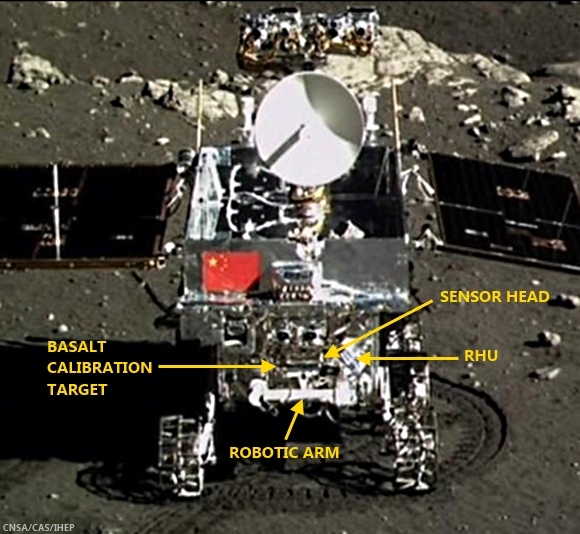 |
| Active Particle-induced X-ray Spectrometer (APXS) components on the Chang'e-3 "Yutu" lunar rover [Xinhua/CNSA/CLEP/IHEP/CAS]. |
The Active Particle-induced X-ray Spectrometer
(APXS), on the Yutu rover delivered to the lunar surface by the Chang’e-3 lunar lander, on December 25 sent back its
first X-ray fluorescence spectrum of the lunar regolith around the landing
site in northwest Mare Imbrium.
The announcement was made by the Institute of High Energy Physics (IHEP) of the Chinese Academy of Sciences (CAS), December 30.
Initial
analysis indicates a marked presence of eight major rock-forming elements: magnesium, aluminum, silicon, potassium, calcium, titanium, chromium and iron (Mg, Al, Si,
K, Ca, Ti, Cr and Fe) and at least three minor elements, strontium, yttrium and zirconium (Sr, Y and Zr) identified in this spectrum.
 |
| First X-ray florescent spectrum of the lunar surface at the Chang'e-3 Mare Imbrium landing site (click to enlarge) [IHEP/CAS]. |
APXS
was initially powered up on December 23, and in-flight calibration, establishing a baseline by analyzing a common basalt rock sample of known composition mounted on the rover, was completed over
five minutes, preparing a stable performance on the lunar surface. After two terrestrial days APXS was successfully deployed to within two to three centimeters over the regolith of Mare Imbrium on the robotic arm of Yutu and began its designed operation.
Complimenting its X-ray spectrometry, the APXS instrument measured returned X-ray
count rate at various distances.
 |
| APXS components (sensor head, radioactive heat unit (RHU) and inflight baseline calibration target [IHEP/CAS]. |

No comments:
Post a Comment